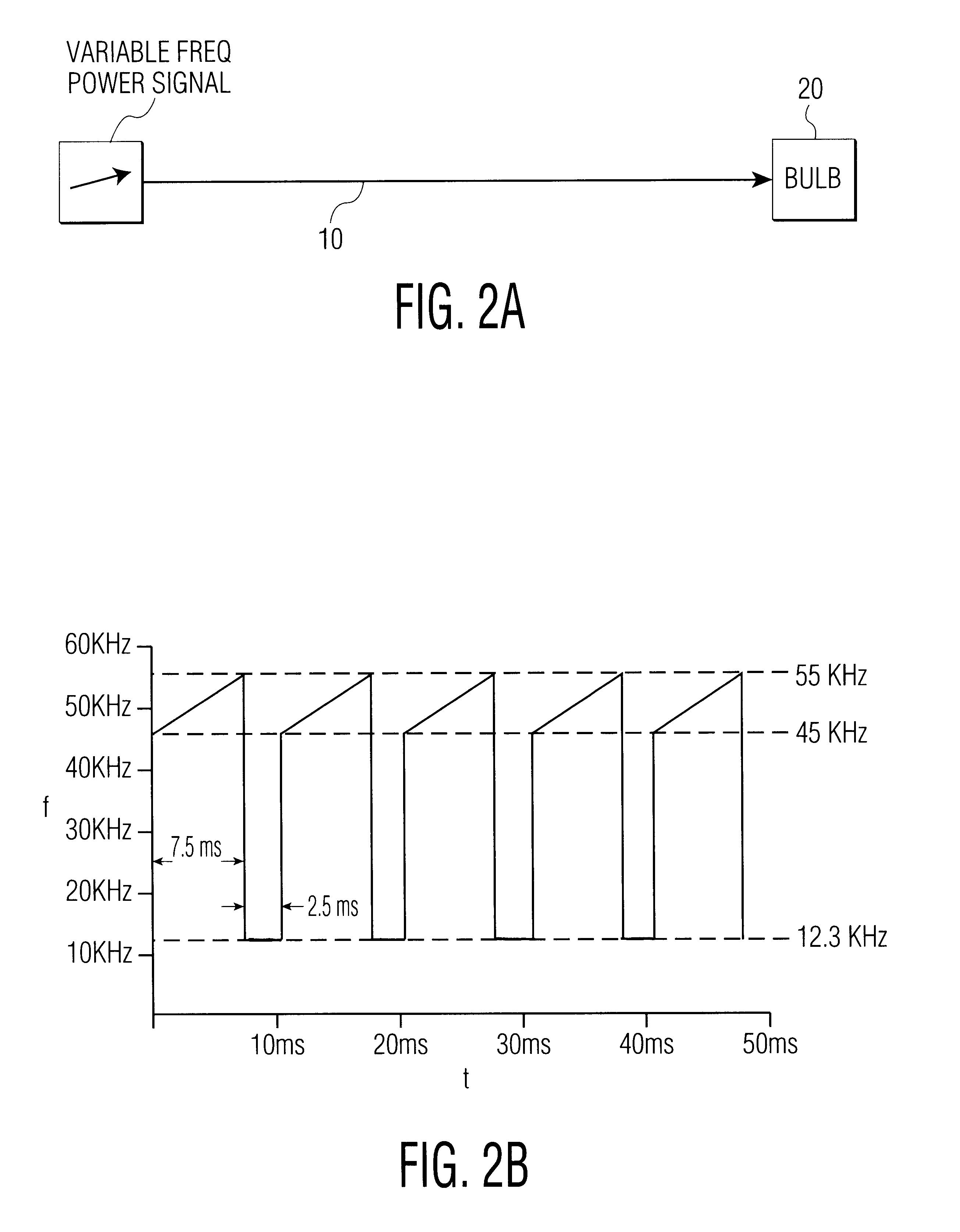Reduction of vertical segregation in a discharge lamp
a discharge lamp and vertical segregation technology, applied in the direction of electric variable regulation, process and machine control, instruments, etc., can solve the problems of inability to complete mixing, disadvantage of having different color properties in vertical and horizontal operation, and inability to have complete mixing, etc., to achieve significant reduction of color segregation, dramatic effect on color properties of lamps, and significant reduction of color temperatur
- Summary
- Abstract
- Description
- Claims
- Application Information
AI Technical Summary
Benefits of technology
Problems solved by technology
Method used
Image
Examples
example 1
A 70 watt, high intensity discharge lamp of cylindrical shape with dimensions or 4 mm ID.times.19 mm IL with 40 bar Hg was operated vertically with a frequency sweep from 45 to 55 kHz in 10 ms. The color properties of the lamp with and without amplitude modulation are set forth in the following table:
Amplitude modulation (A=0.24) decreased the color temperature by about 1300.degree. K, increased the color rendering index (CRI) by 10, increased the x color coordinate and decreased the y color coordinate. The frequency of the second longitudinal mode is at about 22.5 kHz.
example 2
A 70 watt, high intensity discharge lamp of cylindrical shape with dimensions or 4 mm ID.times.19 mm IL with 15 bar Hg was operated vertically (45 to 55 kHz in 10 ms) and horizontally (50 to 60 kHz in 10 ms). The results are set forth in the following table:
Without amplitude modulation the color temperatures in the two orientations differed by about 300.degree. K. Amplitude modulation at the second longitudinal mode (25 kHz) reduced the color temperature by about 500.degree. K in vertical operation and only about 50.degree. K in horizontal operation. The net result was that with amplitude modulation the color temperature in the two orientations differed by about 100.degree. K. Amplitude modulation in horizontal operation moved some of the condensate to positions 1 / 3 and 2 / 3 along the length of the lamp. Moving condensate away from the electrodes could have a beneficial effect on lamp maintenance.
example 3
A 70 watt, high intensity discharge lamp of cylindrical shape with dimensions or 4 mm ID.times.19 mm IL with 15 bar Hg was operated vertically with a current frequency sweep from 45 to 55 kHz in 10 ms. In the table below the color properties of the lamp with swept HF are compared with sequential excitation and amplitude modulation:
Sequential excitation and amplitude modulation both produced similar color properties. Compared to swept HF alone sequential excitation and amplitude modulation decreased the color temperature and the y color coordinate while increasing the color rendering index and the x color coordinate. In the sequential excitation the fixed current frequency of 12.3 kHz corresponds to a power frequency of 24.6 kHz which is close to the frequency of the second longitudinal mode. The similar color properties of the lamp with amplitude modulation and time sequential excitation demonstrate clearly that excitation of the second longitudinal mode reduces vertical segregation...
PUM
 Login to View More
Login to View More Abstract
Description
Claims
Application Information
 Login to View More
Login to View More - R&D
- Intellectual Property
- Life Sciences
- Materials
- Tech Scout
- Unparalleled Data Quality
- Higher Quality Content
- 60% Fewer Hallucinations
Browse by: Latest US Patents, China's latest patents, Technical Efficacy Thesaurus, Application Domain, Technology Topic, Popular Technical Reports.
© 2025 PatSnap. All rights reserved.Legal|Privacy policy|Modern Slavery Act Transparency Statement|Sitemap|About US| Contact US: help@patsnap.com



